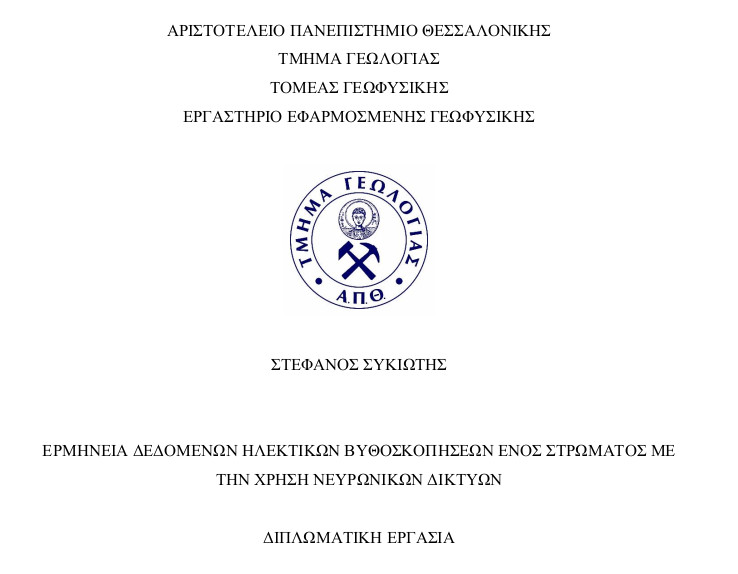
Ερμηνεία δεδομένων ηλεκτρικών βυθοσκοπήσεων ενός στρώματος με τη χρήση νευρωνικών δικτύων = Intepretation of electrical sounding data for single layered subsurface model using neural network.
Περίληψη
χρησιμοποιήθηκε η πλατφόρμα του Google Colaboratory – Colab. Η αρχιτεκτονική του δικτύου είναι ένας συνδυασμός μεταξύ CNN (Convolutional Neural Network) και DNN (Deep Neural
Network) με 2 επίπεδα εισόδου των δεδομένων και 2 επίπεδα εξόδου από τα οποία το ένα έχει ως προϊόν τις 2 τιμές που αντιστοιχούν στις αντιστάσεις των στρωμάτων ενώ το άλλο το πάχος του στρώματος. Ο αλγόριθμος δοκιμάστηκε σε πλήθος συνθετικών δεδομένων αλλά και πραγματικά δεδομένα. Επίσης τα αποτελέσματα συγκρίθηκαν με αυτά που παράγονται με τη μέθοδο της αντιστροφής (λογισμικό IPI2WIN). Σε γενικές γραμμές παρά τις σχετικές αδυναμίες η μέθοδος παρήγαγε ικανοποιητικά αποτελέσματα και αποτελεί τη βάση για την επέκταση του αλγορίθμου σε προβλήματα με περισσότερα στρώματα.
The present diploma thesis deals with the application of neural networks in the interpretation of vertical electrical sounding data for a single layer geoelectrical model. Electrical resistivity sounding is a geoelectrical method of surveying which produces a geoelectrical column of the subsurface based on the vertical change of electrical resistivity below the center of the electrode array assuming that the earth is composed of horizontal layers. This work examines the interpretation of data for the case of a simple layer structure i.e., seeking estimates of the electrical resistance values of the upper layer and the half-space as well as the thickness of the first layer. The aim of this work is the experimental use of neural networks for the interpretation of vertical electrical sounding data concerning single layer models. Neural networks, which in recent years are of growing use, find various applications in all areas as they can offer speed in problem solving but also accuracy. For the studied problem the network was trained with 66000 one-layer models with a wide range of layer resistance and thicknesses values using a simple forward problem solver based on Python. The TensorFlow and Keras library was used to build the network, while the Google Colaboratory - Colab platform was used for the training. The network architecture is a combination between CNN (Convolutional Neural Network) and DNN (Deep Neural Network) with 2 data input levels and 2 output levels, one of which has as a product the two values corresponding to the layer resistances while the other includes a single value which is the thickness of the layer. The algorithm was tested on several synthetic data. The results were also compared with those produced by standard inversion method (IPI2WIN software). In general, despite the relative weaknesses, the method produced satisfactory results and is the basis for extending the algorithm to problems with more layers.
Πλήρες Κείμενο:
PDFΑναφορές
A. Kurniawan (2009). Manual for IPI2WIN - Moscow State University, Geological Faculty, Department of Geophysics
C. Caldero n-Macias, Mr.K. Sen, P.L. Stoffa (2000) Artificial neural networks for parameter estimation in geophysics
C. Darken, J. Chang, & J. Moody (1992). Learning rate schedules for faster stochastic gradient search. Neural Networks for Signal Processing II Proceedings of the 1992 IEEE Workshop, (September), 1–11. http://doi.org/10.1109/NNSP.1992.253713
D. Stut (2014).” Introduction to Neural Networks”, RWTH Aachen University
D.P. Kingma, & J.L. Ba (2015). Adam: A Method for Stochastic Optimization. International Conference on Learning Representations
G. Klambauer, T. Unterthiner, A. Mayr, & S. Hochreiter. (2017). Self-Normalizing Neural Networks. In Advances in Neural Information Processing Systems (NIPS)
H. Kinsley & D. Kukiela. Neural Networks from Scratch (NNFS) https://nnfs.io
L. Bottou, F. E. Curtis, J. Nocedal (2018) Optimization Methods for Large-Scale Machine Learning. arXiv:1606.04838
M. Abadi, A. Agarwal, P. Barham, Eu. Brevdo, Zh. Chen, Cr. Citro, Gr. S. Corrado, A. Davis, J. Dean, M. Devin, S. Ghemawat, I. Goodfellow, A. Harp, G. Irving, M. Isard, R. Jozefowicz, Y. Jia, L. Kaiser, M. Kudlur, J. Levenberg, D. Mané, M. Schuster, R. Monga, Sh. Moore, D. Murray, Chr. Olah, J. Shlens, B. Steiner, Il. Sutskever, K. Talwar, P. Tucker, V.t Vanhoucke, V. Vasudevan, F. Viégas, Or. Vinyals, P. Warden, M. Wattenberg, M. Wicke, Y. Yu, and X. Zheng. (2015) TensorFlow: Large-scale machine learning on heterogeneous systems, 2015. Software available from tensorflow.org.
M. Van der Baan and C. Jutten (2000) Neural networks in geophysical applications.
Geophysics, 65 (4). pp. 1032-1047. ISSN 0016-8033 https://doi.org/10.1190/1.1444797
P. Suriyapor (2020). 1-D Vertical Electrical Sounding (VES) Inversion with a lateral constraint – MAHIDOL UNIVERSITY
S. Ruder (2016). An overview of gradient descent optimisation algorithms. arXiv preprint arXiv:1609.04747.
T. Dozat (2015). Incorporating Nesterov Momentum into Adam
Y. Nesterov, (1983). A method for unconstrained convex minimization problem with the rate of convergence o(1/k2). Doklady ANSSSR (translated as Soviet.Math.Docl.), vol. 269, pp. 543– 547.
Y.L. Ekinci, A. Demirci (2008). A Damped Least-Squares Inversion Program for the Interpretation of Schlumberger Sounding Curves - Çanakkale Onsekiz Mart Üniversitesi-Department of Geophysical Engineering
Α. ΠΑΠΑΔΟΠΟΥΛΟΣ (2016). ΣΥΝΕΛΙΚΤΙΚΑ ΝΕΥΡΩΝΙΚΑ ΔΙΚΤΥΑ ΣΤΗΝ ΥΠΟΛΟΓΙΣΤΙΚΗ ΌΡΑΣΗ. ΠΑΝΕΠΙΣΤΗΜΙΟ ΠΑΤΡΩΝ -ΤΜΗΜΑ ΦΥΣΙΚΗΣ -Δ.Π.Μ.Σ.
Α. ΤΣΕΛΕΝΤΗΣ, Π.ΠΑΡΑΣΚΕΥΟΠΟΥΛΟΣ (2013). ‘ΈΦΑΡΜΟΣΜΕΝΗ ΓΕΩΦΥΣΙΚΗ’, ΕΚΔΟΣΕΙΣ LIBERAL BOOKS
Β. Κ. ΠΑΠΑΖΑΧΟΥ (1996). ‘ΕΙΣΑΓΩΓΗ ΣΤΗΝ ΕΦΑΡΜΟΣΜΕΝΗ ΓΕΩΦΥΣΙΚΗ’ ΕΚΔΟΣΕΙΣ ΖΗΤΗ
Γ. ΒΑΡΓΕΜΕΖΗΣ, Π. ΤΣΟΥΡΛΟΣ (2020-2021). Φυλλάδιο Ασκήσεων εργαστηρίου του μαθήματος ΗΛΕΚΤΡΟΜΑΓΝΗΤΙΚΕΣ ΜΕΘΟΔΟΙ ΓΕΩΦΥΣΙΚΗΣ ΔΙΑΣKΟΠΗΣΗΣ - ΑΡΙΣΤΟΤΕΛΕΙΟ ΠΑΝΕΠΙΣΤΗΜΙΟ ΘΕΣΣΑΛΟΝΙΚΗΣ ΣΧΟΛΗ ΘΕΤΙΚΩΝ ΕΠΙΣΤΗΜΩΝ ΤΜΗΜΑ ΓΕΩΛΟΓΙΑΣ ΤΟΜΕΑΣ ΓΕΩΦΥΣΙΚΗΣ
Εισερχόμενη Αναφορά
- Δεν υπάρχουν προς το παρόν εισερχόμενες αναφορές.
